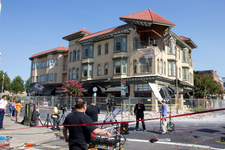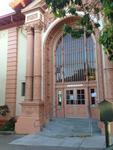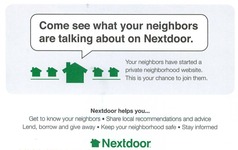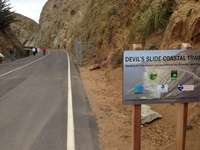 |
| Angelika/Mike Schilli |
Angelika It's no secret that we're living in an area that's often rattled by earthquakes. Small quakes are quite common, and most of them aren't even noticeable. Every once in a while, however, we get a rumble with magnitude 5 on the Richter scale, and depending on where the epicenter is located, it's not unusual that our house keeps swinging back and forth accordingly.
On August 24th at 3:30 a.m., it was swinging a bit more than usual. At this hour, most people are in bed and sleeping, just like we were that night. To this day, Michael claims that I would have slept through the earthquake, had he not woken me up. But that can't be right, I'm pretty sure I woke up right away, it's just that Michael had been up and about shortly before wandering around our appartment, because he thought he had heard someone skulking on the roof of our building, which is something that always gets his attention. That's probably why he wasn't sleeping that deeply. Anyway, were both in bed when the quake started, and waited in horror for a good 15 to 20 seconds until it was finally over. That probably doesn't sound like a long time, but it felt like an eternity. It's amazing what's rushing through your head in 15-20 seconds: Is this the big one? Is it going to get worse? When is it over? Why haven't I closed the closet sliding doors?
I was so glad we had just stocked up on bottled water at Costco the other day! What's interesting is that each earthquake feels differently. Some end with a big bang. The recent quake, however, had a rather smooth rolling motion to it. When it was over, we learned that the epicenter was very close to the city of American Canyon, near Napa Valley, the well-known California wine country. American Canyon is located about 35 miles north-east of San Francisco.
No major damages were reported in San Francisco. In our appartment, a book fell out of its Ikea shelf, and the Ikea bathroom cabinet's door had sprung open. The latter might be attributed to the fact that it was filled to the brim. In the city of Napa, however, the damages were severe. There were people injured, most of them suffering from cuts and bruises, and many houses are uninhabitable now. None of them actually collapsed, but some were so severely damaged that 130 of them were tagged red, which means that they are off-limits now. 1000 buildings were tagged yellow, which means that their use is limited, sometimes only particular parts can be inhabited. The economic damage is tremendous. Rumor has it that wine from the Napa region is going to be more expensive this year, since many vinyards suffered damages from the earthquake.
Angelika On August 18th this year in San Francisco, legions of five-year-olds attended kindergarten for the first time. The summer vacation had ended and a new school year had begun. Although Americans use the German word "kindergarten" for preschool, their concept differs radically from the German education system. In the U.S., kindergarten constitutes the year before first grade, while in Germany, kindergarten is several years of simple and playful daycare for three to five-year-olds. It's not surprising that in the U.S., kindergarten facilities are often located at the preschool buildings. Lately, I've been visiting various preschools as part of my job, where I'm accompanying autistic children to regular kindergartens. I was blown away to see how seriously the young kids are at work cramming facts, instead of enjoying their playtime!
It really is all work and no play. Attending children are scribbling letters of the alphabet, explore reading their first words, deal with numbers and are sitting at classroom desks. Back in my day, obviously quite a long time ago, this is what we only learned later, in school. Some kids clearly have a hard time dealing with this approach. But just like in Germany, there's lots of politics involved when it comes to dealing with the school system, and elected officials love playing around with it. California, for example, proposed the "Kindergarten Readiness Act" in 2010, which pushed out the age by when children must be attending kindergarten. With this measure in place, four-year-olds no longer needed to be sitting in class with five-year-olds, which makes sense, because at this age, differences in development happen quite rapidly. In 2013, the measure was enacted, and only kids who turn five on or before September first can now be registered for kindergarten.
But there's another option for children who were born between September 2nd and December 2nd: They may attend "transitional kindergarten" for a year to bridge the time before going to kindergarten for a year, after which they enter first grade. However, neither transitional kindergarten nor kindergarten are mandatory in California, the only requirement is starting school at age six. Despite that, most kids go to kindergarten, however, because otherwise there's a good chance they would be left behind.
But I digress, what I really wanted to write about is San Francisco's seemingly absurd system to determine which of the various city kindergartens a child can be registered at. To be clear, the following statements only refer to San Francisco's public school system. Private schools or other cities or counties have their own rules and regulations. Back in the days when I went to school in Germany, everyone went to the school in their neighborhood. That's very different today in San Francisco, because here a computer algorithm combined with a lottery determines the appropriate kindergarten for every child. The underlying idea is to open the opportunity for every child living in the city to attend a kindergarten and later a school of their choice. This way, so the school district's argument, children with the same ethnic background won't be concentrated in one school, but every school will get their share of mixed backgrounds, so that for example in a predominantly Asian neighborhood, the nearest school won't be occupied exclusively by Asian children.
During the application process, parents create a ranked list with San Francisco schools of their choice for their kids. There's no limit to how long this list can be. The computer then first tries to assign every parent their first choice. However, as the popular schools fill up, the algorithm then favors children whose siblings are already attending the particular school. Next in line for the popular schools are children from poor neighborhoods with high crime rate, as their schools typically score low on standardized tests. The next priority are children who already attended the particular school's transitional kindergarten. The implementation of this system seems quite absurd to some and causes lots of heated debates.
If a family is living in a neighborhood featuring a highly desired kindergarten, it is every unlikely that their kids can actually attend it if they don't fit in any of the categories above. As a result, many parents desperately try to game the system. For example, it may be a good strategy to avoid listing their first kindergarten choice at the top of the list, if it is a highly desired school in their neighborhood. There's online forums for parents exclusively dedicated to maximizing the chances to get their kids into best possible kindergarten.
In any case, it's a lot of work and stress for the parents, because it's not sufficient to only evaluate the neighborhood's nearest kindergarten. What's worse is that despite the lottery, statistics show that in 25% of all schools the populace won't mix and it's attended by children with predominantly the same ethnicity. One reason for this phenomenon is that in bad neighborhoods with poorly rated schools, parents often don't find the time, or lack the means and the verbal skills to understand the lottery system or even get informed about schools in other neighborhoods. The often choose the easy way and select the poorly rated neighborhood school as their first choice, which they're promptly assigned. It's obvious that San Francisco's school lottery system still needs a lot of work.
Michael Once every week, I'm playing a pickup game with a team of fellow amateur soccer players. Whoever has time to play can reserve a spot on a dedicated web site, and a volunteer takes care of registering the game for a fee with the Recreation and Parks department of the city of San Francisco. It's always great fun to play, and there's even a video of my goal scoring techniques available on Youtube!
Maintenance of all city soccer fields is the responsibility of the San Francisco "Recreation and Parks" department. Sure, there's grass fields in Golden Gate Park that are open for free play, but they often suffer from a lot of pot holes that put players at risk. For the nicely even artificial "astro turf" fields, however, the city wants residents to pay to play. Now, until a few years ago, there used to be a cement surfaced field at the corner of Valencia Street and 20th Street in the Mission neighborhood. Until late at night, this field was in heavy use, because its use was free of charge. Mostly residents of South American origin used to play there passionately, showing off the typical South American street soccer that's very fast, with a lot of dribblings and demonstration of mind-boggling tricks by individual players. Passing the ball is not valued as much and often players try to score instead, even if it's virtually impossible from their angle. You might remember some teams from the last world cup playing in this way.
As I said, the public cement field in the Mission district used to be wildly popular until late into the night, and the South American players adapted the rules from their home countries to fairly share the field: If there's a new team of five to seven players approaching, and the field is already in use by two teams at maximum capacity, the newcomers yell "Reta!". According to the South American backyard soccer rules, the new team then gets swapped in immediatly after one of the teams on the field scores a goal. The scoring team stays on the field, and the losing team must get off the field to make room for the new arrivals. The rotation continues every time a team is scoring a goal, winner stays, losing team gets off and makes room for a swapped-out team, or if there's new arrivals, they get swapped in next.
But when the cement field was remodeled with artificial lawn a few years ago, the city determined that "free play" was now limited to Mondays, Wednesdays, and Fridays, whereas on Tuesdays and Thursdays, paying customers could rent it for $27 per hour for exlusive use. I guess it makes sense to somehow recoup the money for the remodel, but quite predictably, the regulars ignored the inconspicuously posted signs and kept playing, including on the days where the field was rented out. When the paying customers arrived at the scene, waving their permits (Figure 9) around, and demanding to use the field, the kicking and screaming began.
And if the paying players are white software tech workers, while the field is occupied by Latino residents from the neighborhood, the latter are quick to point out that the newcomers have no business telling them what to do. I've witnessed chaotic games where two paying teams were playing on the field, while a third group of obnoxious troublemakers were kicking their ball around as well in the midst of it. The San Francisco Recreation and Parks department obviously likes pocketing the renting fees, but either doesn't have the guts or is simply too lazy to employ someone to make sure that everyone plays by the posted rules. One time, a busybody youth trainer refused to take his 20 children off the field at the agreed-upon time and threatened that if we insisted on our guaranteed play time, he'd capture the whole scene on video to send it to the local newspaper where it would make a nice story titled "Rich White Techies Take Playing Field From Underprivileged Kids".
But since San Francisco software companies are in hot water these days anyway, because they're being accused of displacing the local residents, caused by greedy landlords, who are kicking out low income families, then drive up the rents and let techies move in, it's prudent to operate with caution. Otherwise, sooner or later, the hippie tech bus protesters will get tired of blocking the shuttles (Figure 10 und Rundbrief 02/2014) and will occupy the soccer fields to prevent sport lovers from playing! Anyway, on this memorable evening, we just caved in and let the douche bag proceed. In the meantime, we've switched to renting less controversial fields, hopefully, San Francisco's Recreation and Parks department will get their act together one day.
Michael It's fascinating to watch how much progress the U.S. has made in recent years when it comes to baked goods, especially bread. Going back in history, until the 1980ies, American consumers mainly purchased a rubbery substance called Wonder Bread. And even today, if you're touring outside of the major metropolitan areas, all you'll find in the rural supermarket shelves is bouncy synthetic bread, cut in slices and wrapped in plastic bags. In its raw form, without toasting it, it might very well be a dangerous choking hazard.
Nowadays, crunchy German-style bread is available in hip urban areas, but it is still considered rather foreign to cut off the required slices yourself with a bread knife. Every time I'm buying bread at the Danish "Andersen Bakery", I first need to tell the sales person in no uncertain words that I don't want the loaf sliced, then yell and wave my arms to prevent them from running it through the cutting machine on auto-pilot. Readily sliced bread, an American invention that dates back to 1928, is so common place that the German saying "the best thing since the invention of the wheel" is actually "the best thing since sliced bread" in the United States.
At the hippie supermarket Rainbow Groceries, I recently noticed that the commie comrades there no longer carried my preferred brand of bread made in Berkeley, but replaced it by a really dark rectangular whole wheat bread named "Josey Baker". I usually don't like whole wheat bread, but there was no other choice, so I grudgingly bought it for a whopping $5.99. At home, I cut off a few very thin slices with our German-made WMF bread knife, which was quite a challenge because the bread surface was hard like cement. But I was completely floored when I tasted it, the rich flavor was completely natural, and I liked it so much, that in the meantime, I've gone back and have bought it three times in a row now!
In 2010, a jaunty young entrepeneur named Josey Baker quit his job as a "science curriculum designer" (whatever that is) and started baking bread, first privately, then later in a small shop. Meanwhile, he's baking in the hipster coffee house "The Mill" in San Francisco and sells his fare next to the seating area, alongside the hipster coffee brand "Four Barrel". He's even published a 5-star-rated book on Amazon on 5-star-rated book on Amazon on breaking bread.
In November last year, he even invited German baker Josef Wagner over, who lives in the Starnberger See area near Munich. They had a three week long exchange of recipes and techniques at his shop "The Mill" on Divisadero Street in San Francisco. Maybe Bavarian-born Joseph Wagner told him an old family recipe and that's the reason the bread tastes so great!
Michael Sometimes, I think, that everything on the Internet has already been invented, and then someone comes along and creates something so new, unique, and simple that it's surprising that noone has thought of this before.
For example, in big cities, it's a common problem that people see their neighbors in the building or on the street and say "hello", but it's yet a different story to get to know them close and invite them over to your birthday party. How can you approach these folks? This gap is now being filled by the nextdoor.com website. To register there, they require that you verify your address, and then they unlock the Facebook-like neighborhood forums, where you can post messages, get hitched with friendly neighbors, or get to know who's selling a bicycle, whose house has been haunted by raccoons, or who has had their potted plants stolen from their patio by some low-life.
Because the postings are restricted to the the immediate neighborhood, this allows for much more open communication. If you're living in an expensive part of town and want to buy an item, say, a surfboard from some guy around the corner, there's no reason to assume that anything will go wrong with the transaction. On the other hand, if you respond to an offer on the popular Craigslist online forum for used items, by contacting someone living in a bad neighborhood, you need to consider the possibility that you might end up getting mugged by a crazy meth head who is doing exactly that for a living.
Or would you advertise that your appartment is for rent while you're away for four weeks? If you post this on Craigslist, I recommend you also put a sign at the door that says "Lots of laptops and cameras inside, please take what you need!", since there's lots of shady characters lurking and waiting to take action on news like these. If you post on nextdoor.com, however, it's slightly safer (albeit not really safe), because only people in your immediate posh neighborhood can read it.
The topics discussed on the forum range from complaints about stolen patio plants, reports on gunfire heard at night, crazy panhandlers on 24th Street, nightly noise disturbances, all kinds of burglaries in garages, houses, car break-ins, and tipps on how to protect your pets from brazenly roaming raccoons and skunks. If you, my dear readers in Germany, think that I'm exaggerating here, you have no idea on what it's like to live in the Wild Wild West for twenty years. This isn't sleepy Germany, you really get your high rent money's worth here.
Another side effect of posting under their real name is that it's quite rare that participants in a discussion go haywire and start insulting people. Who would risk to lose face with their neighbors for being abusive online? In expensive neighborhoods like ours, it's also quite common to talk to people with solid education, although I've got to say that in Noe Valley there's also a lot of old hippies who seem to have accumulated money not by a carreer in a lucrative profession, but by sitting in a home for 30 years, purchased by accident in the 80ies with Aunt Sally's inheritance, that's now worth millions.
One side effect of reading Nextdoor news daily, and while constantly finding out about burglaries in our relatively safe neighborhood, is without doubt a higher level of alertness. People tend to worry more, and start investigating if there's a rustling noise in the parking garage at night. On the other hand, it's good to know that other people are also affected, if one's bicycle gets stolen from the garage or one's car is broken into or stolen as well (Rundbrief 03/2012).
Angelika Anyone who has ever been on vacation in San Francisco or California knows Highway 1. This world-renowned dream road snakes along the Pacific Ocean shore and offers fantastic views. Highway 1 is quite curvy and not in the best shape, which often leads parts breaking right off in the winter time during heavy rainstorms. On top of that, mud slides from the adjacent steep slopes often force closures during that time.
Often affected was the so-called "Devil's Slide" section south of San Francisco, very near Michael's weekend surfing spot. This part of Highway 1 was finished in 1937 and every since has been causing nothing but problems. In 1995 and 2006, the section was completely closed for several months, which led to bad traffic congestion and left some of the smaller towns south of the area isolated and cut off from a steady stream of visiting tourists. A big problem for these towns, where many locals make a living relying on visitor dollars!
This is why civil engineers have been hatching plans since the 1960ies to build a bypass further inlands, eliminating the need for "Devil's Slide", to be able to finally close it for traffic. But environmentalists feared that this bypass would trigger a boom in construction near this secluded shoreline and started a decade-long political campaign against it. They favored a tunnel, and in 1996, voters approved the project, with the first groundbreaking ceremony happening in 2005 by officials.
In March 2013, the tunnel finally opened. Government construction projects take forever in California. But now the question arose on what to do with the old section of Highway 1 that was no longer in use. And, I've got to admit, this time a few smart people decided to repurpose the Devil's Slide section to a hiking and biking trail, which opened in 2014 for outdoor enthusiasts and was named "Devil's Slide California Coastal Trail".
We went hiking on the trail for the first time in July and were thrilled. The path really leads along the old road, directly next to the ocean shore and offers expansive views facing the cliffs along the coast line. There are a few newly created vista points with park benches along the way. The trail runs 1.5 miles in each direction (3 miles round trip) and can be accessed on both the north and the south end, where there are parking opportunities and bathrooms. There's not a lot of space for parking, though, which will inevitably lead to problems during the sunny season, especially when word gets around on how great the trail is. Aside from Crissy Field (Rundbrief 02/2007), this is my new favorite hiking trail.
Angelika We've reported a few times already that rental prices in San Francisco have been exploding lately, rendering the city unaffordable to many people. This has led to some animosity targeting well-off techies, living in San Francisco and working in Silicon Valley, but the problem is complex there's several contributing factors. I personally find that landlords play a major role in this game, a role which is quite often conveniently overlooked.
After all, no one forces landlords to raise the rents, which destroys the current city landscape and limits access to city living to a very specific affluent populace. Michael keeps saying that it's naive to think that people won't always act in their best self-interest, but recently, I found out that there are indeed still a number of landlords with integrity left around here.
The other day, I was strolling along 24th Street in our neighborhood. I stopped at the gift store "Just for Fun" and noticed a letter to the customers, displayed in the window by the shop owners David Eiland und Robert Ramsey. Their landlord, Angus Brunner, had just passed away and the two owners emphasized how modest Angus had been towards them. During the economically challenging years 2000 and 2006, a time when many stores in Noe Valley had to close due to sharply declining revenue, Angus stopped by at the store in person and offered them to lower the rent. I was quite moved when I read this.
Michael Despite fierce competition in the package delivery market from private sector companies like UPS and Fedex, the United States Postal Service (USPS) is still in business and offers unbeatable prices on sending letters and packages. Many mail customers appreciate the fact that a standard letter still only costs 49 cents to deliver, regardless if it's just around the corner or if it needs to fly as far as 6,000 miles to Hawaii. I have a hard time believing this kind of legacy deal is sustainable and wouldn't be surprised if USPS ran into financial trouble one day (Rundbrief 09/2011).
Regardless, I'm going to talk about another great deal today. What even many Americans don't know is that USPS offers great prices on sending small packages across the country as well. It's called "First Class Package". Customers unaware of this offering pay between $5.60 and $6.95 for "Priority Mail" packages, but frugal users keep an eye on the package weight not exceeding 13 ounces (368g) and pay between $2.30 and $4.25 for First Class instead.
When shipping items which already weigh close to a dozen ounces, it's a good strategy to avoid heavy cardboard boxes and go with bubble wrap envelopes for packaging instead (Figure 26). Clueless newbies buy bubble wrap envelopes at Walgreens at $1.50 a pop, while experts order a hundred of them on Ebay at $0.20 a piece. But don't be suprised if the box containing those 100 envelopes is a giant cube measuring 30 inches in each dimension!
However, if you think that a bubble wrap mailer passes for large envelope postage, you are sadly mistaken. Even if it's slimmer than the maximum allowed thickness of 3/4 inch, according to our post office guy, a bubble wrap envelope won't pass as a "large envelope" but needs to be sent as "first class package". Paying online is cheaper than at the post office, but since the USPS website is being operated by clueless people, it's almost impossible to pay for your postage there unless you're willing to jump through a lot of hoops. I recommend using the secret Paypal shipping site instead, which accepts your Paypal account balance or a credit card for payment and lets you print shipping labels to be fixed onto the package, which include both the recipient's and the sender's address. Pros print on adhesive labels.
The "Media Mail" option is even cheaper than "First Class Package". But only specific shipments qualify, like books or magazines, or DVDs and CDs including the sometimes heavy slipcases. It only takes a handful of dollars to get a package shipped to the opposite end of the country. Alas, USPS reserves the right to rip open the package during shipment and check if it really contains only media items. And, according to my experience, they sometimes put the shipments on temporary hold for no good reason except sticking it to you for choosing the least expensive option, apparently between unloading them from one truck and loading them onto the next one. When the packages finally arrive at the recipient's address, they often look like they've been exposed to circus elephants stomping around on them.
The bureaucrats in charge of running USPS also have enacted a regulation that says that you can't drop any package into a mailbox that weighs more than 13 ounces (368g). Instead, you have to bring it to the post office even if you paid for postage online! This is a major inconvenience, especially if you know that many post offices in major metropolitan areas are manned by extremly sluggish employees who don't care one bit about providing good service to their customers.
Nothing ruins my day more quickly than after a long day finding a note on our mailbox saying that there was a delivery attempt by USPS and I need to pick up the package at the post office. Because, for some strange reason, this means that I can't pick it up at the nearest location, which is just five blocks from our home, but I need to drive across town to the post office on 18th Street in the Castro district. This location employs the slowest postal workers on earth who hate their lives and I always wonder how it is possible that noone has noticed this and fired them yet. It usually takes them 20 minutes to service five people in line. Luckily, today's smartphones are equipped with the Kindle app that lets you read great American novels while you wait.
In the better run USPS branches, however, the employees there will spot package drop-offs and let you proceed right to the front, even if there's long lines at the counters. When I'm entering our local post office with a package, for example, all I need to do is signal the postal employees at the counters and ask them if it's okay to drop off the package at one of the unmanned counters, and they usually let me proceed and I don't have to stand in line and wait to drop it off.
Shipping cost for "First Class" packages is determined by weight. Packages up to 5 ounces (142g) are only $2.68, regardless if they're destined from San Francisco to a neighboring town in Silicon Valley or at the other end of the continental United States in New York City. A package weighing in at 13 ounces, on the other hand, costs $4.12, that's a bargain often taken advantage of by Ebay sellers!
If the scale shows more than 13 ounces, but still less than a full pound (16 ounces or 453g), the charge for "Priority Mail" to a nearby destination is $5.60, and $6.95 across the country. If it's more than one pound, the package could as well weigh two pounds, because the long distance shipment goes up to a whopping $11.25. If postal employees are weighing the package at the counter and by accident it's only a half-ounce over the limit, then they'll cold-heartedly charge the more expensive rate. In my experience, there's no such thing as a postal worker in the United States who's even slightly bending the rules to give you a break.
One regulation I wasn't aware of until recently determines the dimensions of postcards or envelopes so they still qualify as "machinable". Recently, Angelika sent a birthday card to Germany, contained in an envelope that measured 6 by 7 inches, i.e. almost had square dimensions. It weighed less than 1 ounce (28g), but didn't qualify for the standard international shipping to Germany rate of $1.15. Instead, the post office charged $1.35 for it, because it deviated from the required rectangular shape, being too square-ish. And indeed, as I found out later, section 201.2.0 of the postal code requires not only mininum and maximum width and height of a shipment, but also defines that the ratio of width and height can't be less than 1.3. Doing the math, a 6 by 7 inch envelope has a width/height ratio of 1.17, which is less than 1.3, and therefore shipping cost is more, triggered by the envelope not being "machinable".
If you can manage to figure out how much to pay for shipping and print the label yourself at home, it's often 10-20% cheaper on Ebay or Paypal. Of course, that's out of the question for international shipments, this is when the postal service requires you to show up in person at the post office and fill a paper form only available there. When you hand it to the postal worker behind the counter, they copy the content verbatim into their computer and then glue the label onto the package.
If the shipment goes to Germany, by the way, according to my experience, German customs often halts it and lets it rot in dusty storage rooms for a couple of weeks, while they're rummaging through the content, until they get tired of it and finally hand it to a delivery person. One of these days I'm going to write a lengthy treatise on the topic of why German customs is a taxpayer funded organisation but apparently sees no need to follow any rule of law.
It's telling that Americans still say "shipping" when mailing packages, although, even internationally, hardly anything gets actually sent by ship anymore, unless it's a really heavy item like a table saw. But as the restrictions for airmail in the U.S. continue to become more and more ridiculuous, shipments by ship may become viable again. Recently, the German Amazon.de site even stopped shipping beauty products like bottles with hair shampoo (Abbildung 32) to the U.S.!
Greetings from bureaucracy central:
Angelika & Michael





































